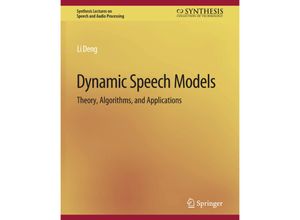Speech dynamics refer to the temporal characteristics in all stages of the human speech
communication process. This speech chain starts with the formation of a linguistic message in a
speaker's brain and ends with the arrival of the message in a listener's brain. Given the
intricacy of the dynamic speech process and its fundamental importance in human communication
this monograph is intended to provide a comprehensive material on mathematical models of speech
dynamics and to address the following issues: How do we make sense of the complex speech
process in terms of its functional role of speech communication? How do we quantify the special
role of speech timing? How do the dynamics relate to the variability of speech that has often
been said to seriously hamper automatic speech recognition? How do we put the dynamic process
of speech into a quantitative form to enable detailed analyses? And finally how can we
incorporate the knowledge of speech dynamics into computerized speech analysis and recognition
algorithms? The answers to all these questions require building and applying computational
models for the dynamic speech process.What are the compelling reasons for carrying out dynamic
speech modeling? We provide the answer in two related aspects. First scientific inquiry into
the human speech code has been relentlessly pursued for several decades. As an essential
carrier of human intelligence and knowledge speech is the most natural form of human
communication. Embedded in the speech code are linguistic (as well as para-linguistic) messages
which are conveyed through four levels of the speech chain. Underlying the robust encoding and
transmission of the linguistic messages are the speech dynamics at all the four levels.
Mathematical modeling of speech dynamics provides an effective tool in the scientific methods
of studying the speech chain. Such scientific studies help understand why humans speak as they
do and how humans exploit redundancy and variability by way of multitiered dynamic processes to
enhance the efficiency and effectiveness of human speech communication. Second advancement of
human language technology especially that in automatic recognition of natural-style human
speech is also expected to benefit from comprehensive computational modeling of speech
dynamics. The limitations of current speech recognition technology are serious and are well
known. A commonly acknowledged and frequently discussed weakness of the statistical model
underlying current speech recognition technology is the lack of adequate dynamic modeling
schemes to provide correlation structure across the temporal speech observation sequence.
Unfortunately due to a variety of reasons the majority of current research activities in this
area favor only incremental modifications and improvements to the existing HMM-based
state-of-the-art. For example while the dynamic and correlation modeling is known to be an
important topic most of the systems nevertheless employ only an ultra-weak form of speech
dynamics e.g. differential or delta parameters. Strong-form dynamic speech modeling which is
the focus of this monograph may serve as an ultimate solution to this problem.After the
introduction chapter the main body of this monograph consists of four chapters. They cover
various aspects of theory algorithms and applications of dynamic speech models and provide a
comprehensive survey of the research work in this area spanning over past 20~years. This
monograph is intended as advanced materials of speech and signal processing for graudate-level
teaching for professionals and engineering practioners as well as for seasoned researchers
and engineers specialized in speech processing

